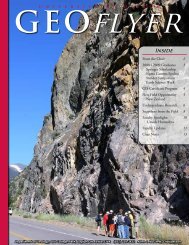Stander Symposium abstract book - University of Dayton
Stander Symposium abstract book - University of Dayton
Stander Symposium abstract book - University of Dayton
You also want an ePaper? Increase the reach of your titles
YUMPU automatically turns print PDFs into web optimized ePapers that Google loves.
POSTER SESSION 1<br />
The Transformation <strong>of</strong> The Wheels for Kids Organization from a First Year Engineering<br />
Design Project to a Year-Long Service Learning Project.<br />
Presenter(s): Joseph R Radisek<br />
Advisor(s): David A Herrelko, Joanne M Troha<br />
Fitz Center for Leadership in Community - Independent Research<br />
Wheels for Kids was started by Dr. Herrelko in 2001 as a service-learning project for the first year students <strong>of</strong> the New Engineers Program. The<br />
project consisted <strong>of</strong> students collecting bicycles from the <strong>Dayton</strong> area and fixing them. The students organized and ran all aspects, including how<br />
the bicycles were collected, how the class was to be trained in fixing bicycles, and the preparation for the Wheels for Kids Day. The day was the<br />
culmination <strong>of</strong> the class, where the fixed bicycles were distributed to the local youth while learning maintenance and safety lessons. Joe Radisek<br />
participated in the last year (2008) <strong>of</strong> the original Wheels for Kids design. Since 2008, students from the <strong>University</strong> <strong>of</strong> <strong>Dayton</strong> have continued on<br />
the spirit <strong>of</strong> the Wheels for Kids project. Today, with assistance from the School <strong>of</strong> Engineering and the Fitz Center, Wheels for Kids is a recognized<br />
service organization on campus. The club works year-round collecting bicycles from the <strong>Dayton</strong> area, fixing them, and distributing them to the<br />
local youth with safety and maintenance training at the Wheels for Kids Day. Joe Radisek has been a leader in Wheels for Kids throughout this<br />
transitional phase and currently holds the position <strong>of</strong> Vice-President in the organization. As Joe plans to graduate in May 2012, this presentation<br />
provides an opportunity for him to impart his wisdom and insight. This includes the first hand experiences from the past five years <strong>of</strong> Wheels for<br />
Kids projects.<br />
Changes in Precipitation Regimes in the United States<br />
Presenter(s): Thomas A Davis<br />
Advisor(s): Shuang-Ye Wu<br />
Geology - Senior/Capstone Project<br />
This study aims to investigate how climate change has affected precipitation patterns in the US. Precipitation provides us with freshwater, the<br />
most vital resources for life; but it also brings damages from extreme storms and flooding. There are three major mechanisms <strong>of</strong> precipitation in<br />
the United States: (1) frontal storms dominate during colder months from late fall to early spring and generally last for longer periods <strong>of</strong> time;<br />
(2) convective storms or âpop-up thunderstormsâ are more common during late spring and summer, and typically bring more intense rainfall for<br />
shorter period <strong>of</strong> time, and (3) precipitation due to orographic lifting in mountainous regions. The objectives <strong>of</strong> this study are to establish (1) if<br />
precipitation regimes have changed in the United States in the past 60 years as a result <strong>of</strong> climate change, and (2) if changes in precipitation patterns<br />
are similar for different types <strong>of</strong> storms and (3) if changes in precipitation patterns are similar in different climate regions. For this purpose,<br />
we used hourly and daily precipitation data from 1900 through 2010 collected from National Climate Data Center and US Historical Climatology<br />
Network to look for trends in the frequency and intensity <strong>of</strong> storms <strong>of</strong> various durations, and examine the statistical significance <strong>of</strong> these trends.<br />
The investigation is conducted in GIS in order to examine spatial variations <strong>of</strong> such changes.<br />
Overview <strong>of</strong> glacier velocity across Himalaya<br />
Presenter(s): Anthony T Parkes<br />
Advisor(s): Umesh K Haritashya<br />
Geology - Senior/Capstone Project<br />
Glaciers, in general, are highly sensitive to climate fluctuations making them important indicators <strong>of</strong> climate change. Overall, lack <strong>of</strong> data on this<br />
region is troubling for the amount <strong>of</strong> hydrological importance and climatic forecasts these glaciers hold. Therefore, this study aimed to measure<br />
glacier velocity on selected glaciers using cross-correlation techniques. One <strong>of</strong> the main problems with determining the amount <strong>of</strong> loss or perhaps<br />
gain in glacier mass is determining their velocity. The Himalayan glaciers are inaccessible in most areas and field measurements can be impossible,<br />
which creates a problem when determining the velocity <strong>of</strong> glaciers. Consequently, I generated velocity pr<strong>of</strong>iles <strong>of</strong> glaciers in the Nanga Parbat<br />
region <strong>of</strong> the western Himalaya using 2009 and 2010 ASTER satellite data. My glacier fluctuation study has shown oscillating behavior <strong>of</strong> these<br />
glaciers; however, our preliminary velocity result indicates high velocity on most <strong>of</strong> these glaciers. These results I produced are the first ever velocity<br />
pr<strong>of</strong>ile generated for this region.<br />
39

















